Pumpkins seem to be everywhere this fall with the except of the ones ideal for making pumpkin bread. I have seen small, decorator size ones and large jack of lantern ones. Hopefully the sugar pie pumpkins they will arrive in the stores or market soon. In the meantime, use canned organic pumpkin which works well in this yummy sweetbread. This is my daughter’s favorite snack and am sure it will become a favorite with your family too.

If someone is allergic to chicken eggs, then you can make my eggless bread or vegan bread. The eggless is pretty close in flavor and texture. I use duck eggs which have a different protein than chicken eggs. Our son can eat duck eggs even though he is allergic to chicken eggs. While researching duck eggs, I have found out duck eggs contain more B12, Vitamin E, Vitamin D and Vitamin A and omega 3′s than chicken eggs. They are richer which improves the flavor of cakes and breads. There is a higher fat content and more cholesterol as well.
Since we usually devour the first loaf within 24 hours, I recommend making two loaves and not cutting this recipe in half to make one. Freeze the second loaf so you have an healthy snack for the kids. You can easily slice a piece for them to take to school in the morning before they leave. The bread completely thaws within the hour and is ready for them to enjoy at snack or lunch time.
My kids absolutely love this pumpkin bread and it gives them the needed energy to help them focus. The complex carbohydrates provides the energy to recharge their brains. These complex carbohydrates combined with the fiber helps regulate their blood sugar so hopefully it counteracts the sugar in the bread. Use coconut sugar if your kids have blood sugar issues to be on the safe side! The cinnamon helps with insulin levels too. Or you can also cut out the sugar completely but it will make it much more “bready.” If you cut out the sugar, I recommend adding some raw honey on the slice to enhance the flavor.
My husband and kids do not like nut pieces in their bread but they cannot taste the nuts in the hazelnut flour. I love the texture it adds as well. I recommend adding the hazelnut meal to the bread for the protein, fiber and minerals (magnesium, vitamin E, B vitamins, manganese, potassium, calcium, copper, iron, zinc, and selenium).
Hazelnuts are a good source of energy and kids need a boost during the long school day. Around 2 o’clock I need a boost too. If you do not have hazelnut flour, use 3 1/2 cups of your all purpose flour. Next time order the Red Mill Hazelnut flour online or get it at Whole Foods. I use it in all my breads.
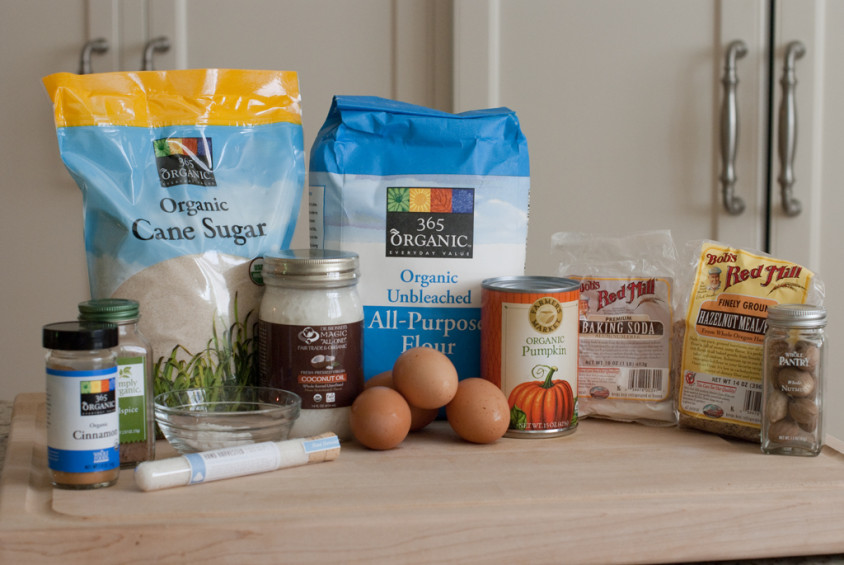
Directions
1) With a hand mixer on medium to high, whip the 4 cage free eggs, 1 cup of coconut or canola oil and 2.5 cups of organic pumpkin. Note: You can use one 16 ounce can of pumpkin but I found the bread to be much better with a little more pumpkin. I know you will have leftovers in the second can but it is worth it. Put the extra puree on your dog’s food. They will love you for it and they get a ton of nutrients too!
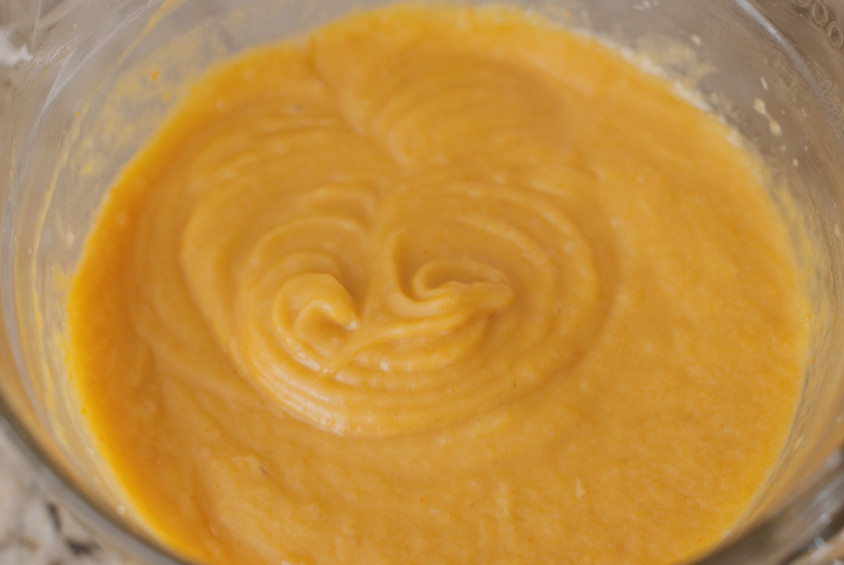
2) Add the 3 cups of flour, 1/2 cup of hazelnut flour, 3 cups of cane or coconut sugar, 1/2 teaspoon baking soda, 1 1/2 teaspoon fleur de sel, 1 1/2 teaspoons allspice, 1 1/2 teaspoons freshly grated nutmeg (you can use ground nutmeg), and 2 teaspoons organic cinnamon. Mix on medium until all the lumps are removed.
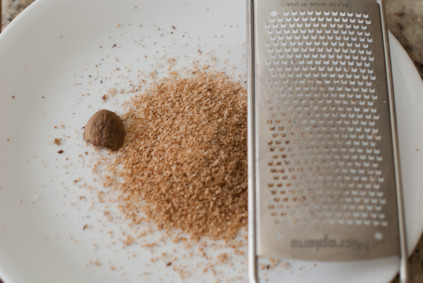
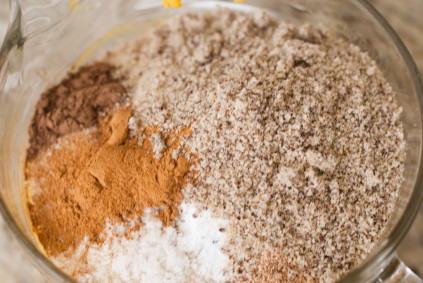
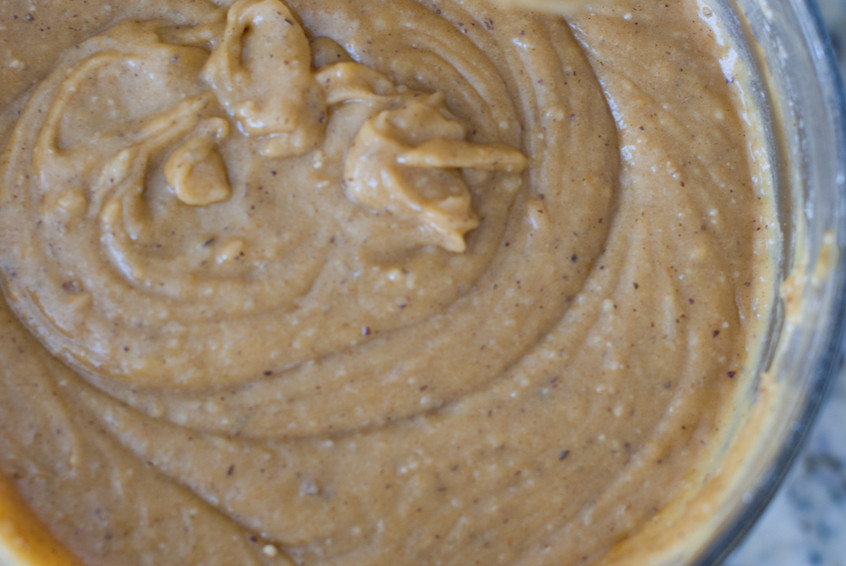
3) Grease the 9 x 5 x 3 load pan with coconut oil and preheat oven to 300 degrees.
4) Pour the batter into the pan and bake in the preheated oven for 60 to 75 minutes. Mine takes 70 minutes. I love my breads a little soft in the middle.
5) These breads make wonderful gifts. The holidays will be here before you know it. Go to My Own Labels and create your own custom label and give them to your children’s teachers or bring as hostess gifts. They are a huge hit with our friends and neighbors.
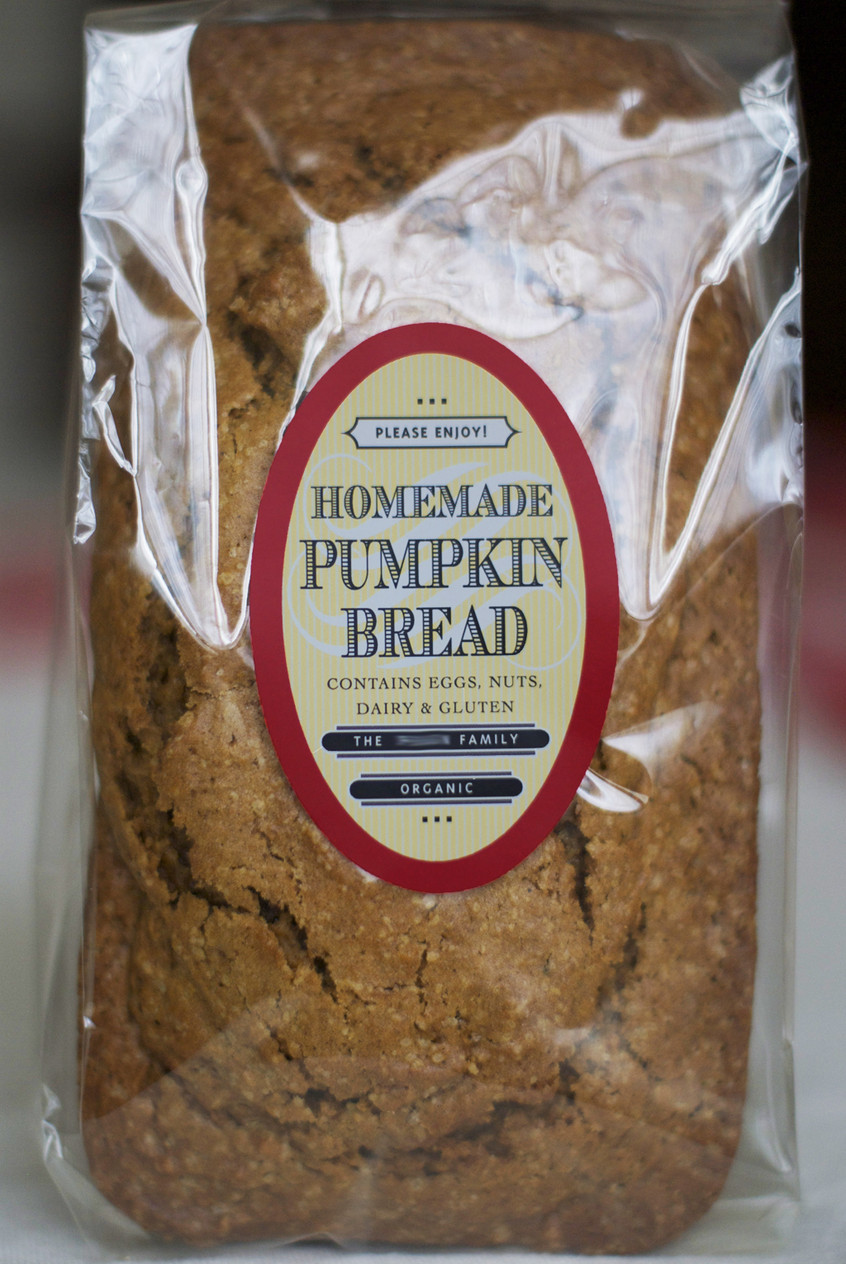
Why you want to eat this!
Pumpkin
- Each cup of canned pumpkin contains 80 calories, 1 g of fat, 20 g of carbohydrate and 7 g of fiber. It also provides 760 percent of the daily value of vitamin A, 17 percent of vitamin C, 6 percent of calcium and 19 percent of iron. Some canned pumpkin may have salt added, containing almost 600 mg per cup serving.
- Carbohydrates- Carbohydrates are an energy source for muscles and the brain. In fact, carbohydrates are the only energy source for the brain. Canned pumpkin is a complex carbohydrate source, and because it contains both carbohydrates and fiber, it can help prevent extreme fluctuations in blood sugar levels. This is especially important for people with diabetes and other conditions that require consistent blood sugar levels.
- Fiber- The American Heart Association suggests consuming approximately 25 g of fiber a day. With 7 g per cup, canned pumpkin can help you reach that goal. Fiber adds bulk to the diet, aiding in digestion, alleviating constipation and helping to lower cholesterol. In addition, fiber increases the feeling of fullness, or satiety, which can play a role in weight management.
- Vitamin A- Canned pumpkin is a source of vitamin A, which is an antioxidant. Antioxidants help reduce free radical damage, thus helping to prevent cell damage that may cause chronic diseases and contribute to aging. In canned pumpkin, vitamin A is in the form of beta-carotene. Beta-carotene, a carotenoid, also gives pumpkin its orange color. Other health benefits of beta-carotene include improved eye health as well as proper formation and growth of mucus membranes, soft tissues and skin.
- Vitamin C- A water-soluble vitamin, vitamin C plays an important role in tissue growth and repair, thus making vitamin C necessary in wound healing and the proper development of ligaments, scar tissue, gums and teeth.
- Calcium- Another nutrient in canned pumpkin is the mineral calcium. Calcium plays an important role in bone health and can help reduce the risk of osteoporosis. Other functions of calcium include blood clotting, cellular signaling and muscle contraction, including contraction of the heart.
- Iron- A mineral in every cell in the body, iron is necessary for the development of red blood cells and aids in transportation of oxygen to tissues. The iron in canned pumpkin is more readily absorbed. This is because vitamin C increases the absorption of non-heme iron, which is iron from plant sources. Read more (I could not have said this better than this Livestrong description)

Cinnamon
- Cinnamon is an excellent source of manganese and fiber. It also has potassium, calcium, iron, zinc and magnesium. Cinnamon may help the body regulate blood sugar levels and can be beneficial in high carb foods liked baked breads. The spice helps the body respond to insulin so it may be helpful for individuals with type 2 diabetes.
- Cinnamon may be good for individuals with platelet issues or at risk for stroke or heart attacks since Cinnamaldehyde prevents platelets from clogging in the blood vessels.
- The smell is invigorating and may help adults and children focus and improve brain activity. “Research led by Dr. P. Zoladz and presented April 24, 2004, at the annual meeting of the Association for Chemoreception Sciences, in Sarasota, FL, found that chewing cinnamon flavored gum or just smelling cinnamon enhanced study participants’ cognitive processing. Specifically, cinnamon improved participants’ scores on tasks related to attentional processes, virtual recognition memory, working memory, and visual-motor speed while working on a computer-based program.” read more
Hazelnuts
- Rich in fiber, folate, vitamin E, B-complex groups of vitamins such as riboflavin, niacin, thiamin, pantothenic acid, pyridoxine (vitamin B-6), manganese, potassium, calcium, copper, iron, magnesium, zinc, and selenium.
- 100 g nuts provide 628 calories.
- “The nuts are rich in mono-unsaturated fatty acids like oleic as well as essential fatty acid linoleic acid that help lower LDL or bad cholesterol and increase HDL or good cholesterol.” read more
- Gluten free food
References:
Recipe adapted from “A Taste of Georgia” Cookbook, Mrs. Charles F. Colbert III (Pat), Pittsburgh, Pennsylvania
https://www.whfoods.com/genpage.php?tname=foodspice&dbid=68
https://www.nutrition-and-you.com/cinnamon-spice.html
https://www.nutrition-and-you.com/hazelnuts.html
